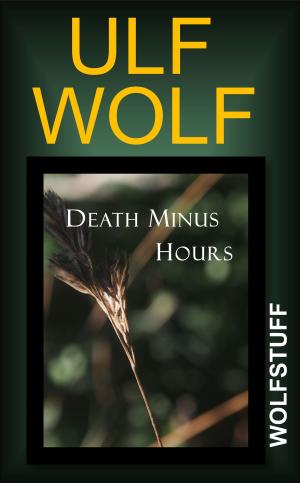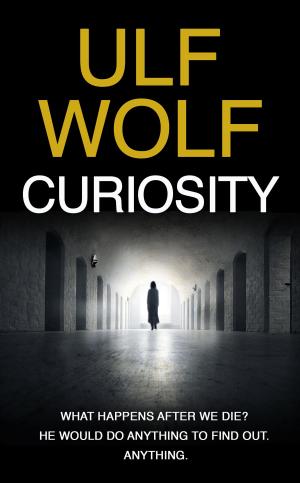| Author: | Ulf Wolf | ISBN: | 9781370407989 |
| Publisher: | Ulf Wolf | Publication: | August 25, 2016 |
| Imprint: | Smashwords Edition | Language: | English |
| Author: | Ulf Wolf |
| ISBN: | 9781370407989 |
| Publisher: | Ulf Wolf |
| Publication: | August 25, 2016 |
| Imprint: | Smashwords Edition |
| Language: | English |
Professor God stepped a little closer, then bent forward and gazed over his student’s shoulder and down on the trial universe soon to form under the transparent reality dome in front of them. Then he frowned, straightened, and said “No. No. No. That’s too many.”
Student God, a creative and eager-to-learn lad of about eight or so billion years turned away from the dome under which he was constructing the first molecule, and looked up at the professor, then turned back to the shiny, spinning construct hovering, quite visible for its small size, in the sterile and shielded midair. He regarded it silently for some time, as if stalling or as if deciding how best to break some unpleasant news. Then he turned again and looked back up at Professor God.
“Sir,” he began. “God Gray’s Book on Universes is quite clear on this point. For optimal expansive ramifications, which is what I’m aiming for here, Gray says eight, or even ten.”
“And your nucleus ratio?”
“Eight positives and two true neutrals.”
Professor God, tall and ancient—give or take a few billion—drew himself even further erect, if that were possible, and re-frowned. “My Book on Universes does not hold that view,” he said.
“Yes, sir, I know. You recommend four electrons and a lighter kernel.”
“Yes I do. And you can take my word for this: you do not want more than four. Eight, in my experience, is to court disaster. It also makes for twice the gravity. Have you thought about that?”
Student God had thought about that, but gravity was not his main concern here. So, instead of answering, he said, “Gray says four will make it too rigid, even prone to implosion.”
“I know what Gray says.”
“I know you two don’t see eye to eye, sir.”
“I have tried it both ways,” the good professor replied, “and I have created a few more universes than Gray has. I grant that Gray looks good on paper, well-reasoned. It may come as a surprise to you, but I know Gray quite well. Brilliant God, quite brilliant, but not one to get his hands dirty, not if he can help it, if you know what I mean. Very particular about his manicure. A little, what is the word…?”
“Fastidious?”
“Yes, that’s it. Fastidious.”
Professor God continued to regard the hovering molecule in silence, then—with four quick pinpoint glances—turned black four of the eight little electrons darting around the nucleus at God-like speed.
Then he said, “Those four, the black ones, take them out.”
Student God looked at them for a while, then vanished them. After another while he said, “I have to adjust the kernel.”
“Naturally.”
“Four and two?”
“You know that in the first molecule two neutrals can serve as one positive.” This he said like a question.
“Yes, I do. I would keep them true neutrals, though.”
“Or?”
“Or, I could use three protons and two neutrals, the two forming one positive to make four.”
“Indeed.”
“How do you determine the best way to go?” Student God asked.
“Trial and error,” said Professor God. “That’s why you’re here, isn’t it?”
“Yes,” said Student God and reduced the kernel to three positives and two neutrals—pseudo-neutrals to be exact, since they added up to one positive—feeling safe in constructing what had been suggested (if not outright demanded) by his professor.
“That looks good,” said Professor God. “Why don’t you test it.”
“For how long do you think?”
“I would simulate a billion or so years, at least.” ...
Professor God stepped a little closer, then bent forward and gazed over his student’s shoulder and down on the trial universe soon to form under the transparent reality dome in front of them. Then he frowned, straightened, and said “No. No. No. That’s too many.”
Student God, a creative and eager-to-learn lad of about eight or so billion years turned away from the dome under which he was constructing the first molecule, and looked up at the professor, then turned back to the shiny, spinning construct hovering, quite visible for its small size, in the sterile and shielded midair. He regarded it silently for some time, as if stalling or as if deciding how best to break some unpleasant news. Then he turned again and looked back up at Professor God.
“Sir,” he began. “God Gray’s Book on Universes is quite clear on this point. For optimal expansive ramifications, which is what I’m aiming for here, Gray says eight, or even ten.”
“And your nucleus ratio?”
“Eight positives and two true neutrals.”
Professor God, tall and ancient—give or take a few billion—drew himself even further erect, if that were possible, and re-frowned. “My Book on Universes does not hold that view,” he said.
“Yes, sir, I know. You recommend four electrons and a lighter kernel.”
“Yes I do. And you can take my word for this: you do not want more than four. Eight, in my experience, is to court disaster. It also makes for twice the gravity. Have you thought about that?”
Student God had thought about that, but gravity was not his main concern here. So, instead of answering, he said, “Gray says four will make it too rigid, even prone to implosion.”
“I know what Gray says.”
“I know you two don’t see eye to eye, sir.”
“I have tried it both ways,” the good professor replied, “and I have created a few more universes than Gray has. I grant that Gray looks good on paper, well-reasoned. It may come as a surprise to you, but I know Gray quite well. Brilliant God, quite brilliant, but not one to get his hands dirty, not if he can help it, if you know what I mean. Very particular about his manicure. A little, what is the word…?”
“Fastidious?”
“Yes, that’s it. Fastidious.”
Professor God continued to regard the hovering molecule in silence, then—with four quick pinpoint glances—turned black four of the eight little electrons darting around the nucleus at God-like speed.
Then he said, “Those four, the black ones, take them out.”
Student God looked at them for a while, then vanished them. After another while he said, “I have to adjust the kernel.”
“Naturally.”
“Four and two?”
“You know that in the first molecule two neutrals can serve as one positive.” This he said like a question.
“Yes, I do. I would keep them true neutrals, though.”
“Or?”
“Or, I could use three protons and two neutrals, the two forming one positive to make four.”
“Indeed.”
“How do you determine the best way to go?” Student God asked.
“Trial and error,” said Professor God. “That’s why you’re here, isn’t it?”
“Yes,” said Student God and reduced the kernel to three positives and two neutrals—pseudo-neutrals to be exact, since they added up to one positive—feeling safe in constructing what had been suggested (if not outright demanded) by his professor.
“That looks good,” said Professor God. “Why don’t you test it.”
“For how long do you think?”
“I would simulate a billion or so years, at least.” ...















